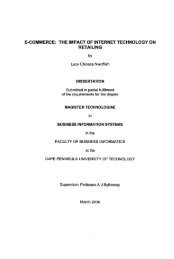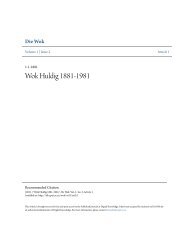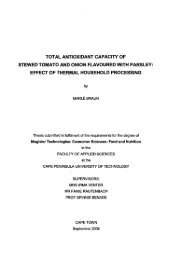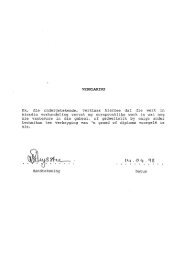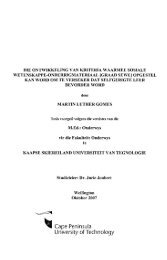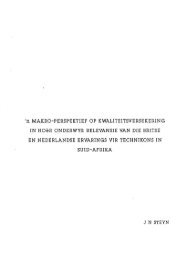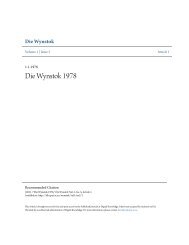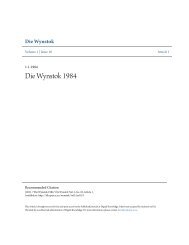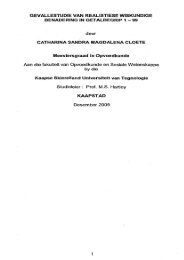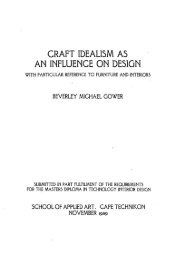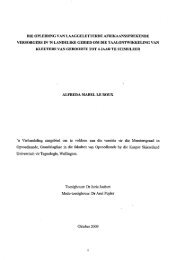the effect of the particle size distribution on non-newtonian turbulent ...
the effect of the particle size distribution on non-newtonian turbulent ...
the effect of the particle size distribution on non-newtonian turbulent ...
Create successful ePaper yourself
Turn your PDF publications into a flip-book with our unique Google optimized e-Paper software.
Chapter 5 Discussi<strong>on</strong> Page 5.10<br />
Moody chart. This is ano<str<strong>on</strong>g>the</str<strong>on</strong>g>r downfall <str<strong>on</strong>g>of</str<strong>on</strong>g><str<strong>on</strong>g>the</str<strong>on</strong>g> Bowen method. However, if using <str<strong>on</strong>g>the</str<strong>on</strong>g> Slatter<br />
method you would simply select <str<strong>on</strong>g>the</str<strong>on</strong>g> appropriate roughness <str<strong>on</strong>g>effect</str<strong>on</strong>g> for <str<strong>on</strong>g>the</str<strong>on</strong>g> Roughness Reynolds<br />
Number (ie. <str<strong>on</strong>g>the</str<strong>on</strong>g> representative <str<strong>on</strong>g>particle</str<strong>on</strong>g> <str<strong>on</strong>g>size</str<strong>on</strong>g> or <str<strong>on</strong>g>the</str<strong>on</strong>g> pipe hydraulic roughness, whichever is <str<strong>on</strong>g>the</str<strong>on</strong>g><br />
greater). It is suggested however, that test work is first c<strong>on</strong>ducted in smooth pipes to ensure<br />
that <str<strong>on</strong>g>particle</str<strong>on</strong>g> roughness turbulence is indeed occurring. If testing takes place in a pipe with<br />
pipe hydraulic roughness higher than <str<strong>on</strong>g>the</str<strong>on</strong>g> representative <str<strong>on</strong>g>particle</str<strong>on</strong>g> <str<strong>on</strong>g>size</str<strong>on</strong>g> <str<strong>on</strong>g>the</str<strong>on</strong>g> <str<strong>on</strong>g>particle</str<strong>on</strong>g> roughness<br />
<str<strong>on</strong>g>effect</str<strong>on</strong>g> will not be detected.<br />
This investigati<strong>on</strong> does highlight <str<strong>on</strong>g>the</str<strong>on</strong>g> fact that <str<strong>on</strong>g>the</str<strong>on</strong>g> <str<strong>on</strong>g>particle</str<strong>on</strong>g> roughness <str<strong>on</strong>g>effect</str<strong>on</strong>g> is valid for <str<strong>on</strong>g>the</str<strong>on</strong>g><br />
slurries tested and must be used in <strong>turbulent</strong> flow modelling. The <str<strong>on</strong>g>particle</str<strong>on</strong>g> roughness <str<strong>on</strong>g>effect</str<strong>on</strong>g><br />
should be incorporated in <str<strong>on</strong>g>the</str<strong>on</strong>g> <strong>turbulent</strong> analysis <str<strong>on</strong>g>of</str<strong>on</strong>g> n<strong>on</strong>-Newt<strong>on</strong>ian slurries, as has been used<br />
in <str<strong>on</strong>g>the</str<strong>on</strong>g> <str<strong>on</strong>g>the</str<strong>on</strong>g>ory for Slatter's analysis, to account for rough wall <strong>turbulent</strong> flow and to predict<br />
<str<strong>on</strong>g>the</str<strong>on</strong>g> change from smooth wall to rough wall <strong>turbulent</strong> flow.<br />
5.8 REYNOLDS NUMBER VS FRICTION FACTOR PLOTS<br />
Figure 5.3 to Figure 5.5 shows <str<strong>on</strong>g>the</str<strong>on</strong>g> plot <str<strong>on</strong>g>of</str<strong>on</strong>g> Reynolds number vs fricti<strong>on</strong> factor, also called<br />
Moody plots, for <str<strong>on</strong>g>the</str<strong>on</strong>g> Newt<strong>on</strong>ian approximati<strong>on</strong> Reynolds Number, Metzner & Reed Reynolds<br />
Number, and a Reynolds number published by Slatter & Lazarus (1993) <str<strong>on</strong>g>of</str<strong>on</strong>g> <str<strong>on</strong>g>the</str<strong>on</strong>g> form<br />
Re = 8 P V 2<br />
Ty"'K D<br />
[ 8V) n<br />
(5.1)<br />
which can be derived by c<strong>on</strong>sidering <str<strong>on</strong>g>the</str<strong>on</strong>g> Newt<strong>on</strong>ian approximati<strong>on</strong> and substituting <str<strong>on</strong>g>the</str<strong>on</strong>g> bulk<br />
shear rate in place <str<strong>on</strong>g>of</str<strong>on</strong>g> true shear rate (Slatter, 1994). Included in <str<strong>on</strong>g>the</str<strong>on</strong>g> plots are <str<strong>on</strong>g>the</str<strong>on</strong>g> laminar<br />
flow line (ie. f=16/Re) and <str<strong>on</strong>g>the</str<strong>on</strong>g> Prandtlline (Newt<strong>on</strong>ian smooth wall).<br />
The Moody chart shows that for <str<strong>on</strong>g>the</str<strong>on</strong>g> <strong>turbulent</strong> flow <str<strong>on</strong>g>of</str<strong>on</strong>g> Newt<strong>on</strong>ian fluids, pipe roughness can<br />
have an appreciable <str<strong>on</strong>g>effect</str<strong>on</strong>g>. As can be seen from Figure 5.3 <str<strong>on</strong>g>the</str<strong>on</strong>g> <strong>turbulent</strong> flow data tends to<br />
lie in straight horiz<strong>on</strong>tal lines for <str<strong>on</strong>g>the</str<strong>on</strong>g> various slurries and does not follow <str<strong>on</strong>g>the</str<strong>on</strong>g> oblique Prandtl<br />
line as suggested by Kemblowski & Kolodziejski (1973). This indicates that f is c<strong>on</strong>stant<br />
with increasing Reynolds numbers and hence it is independent <str<strong>on</strong>g>of</str<strong>on</strong>g> rheology. This trend is




